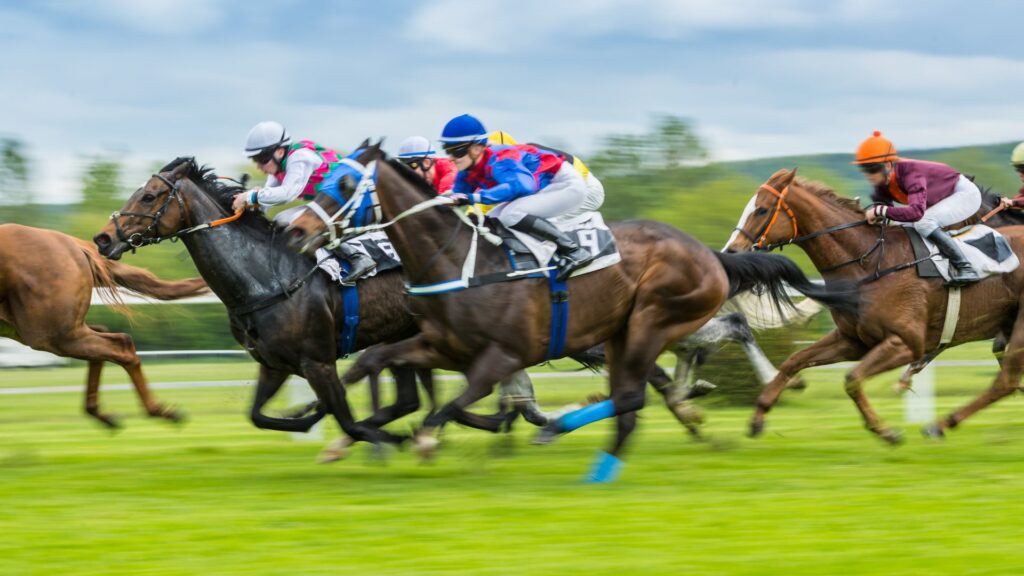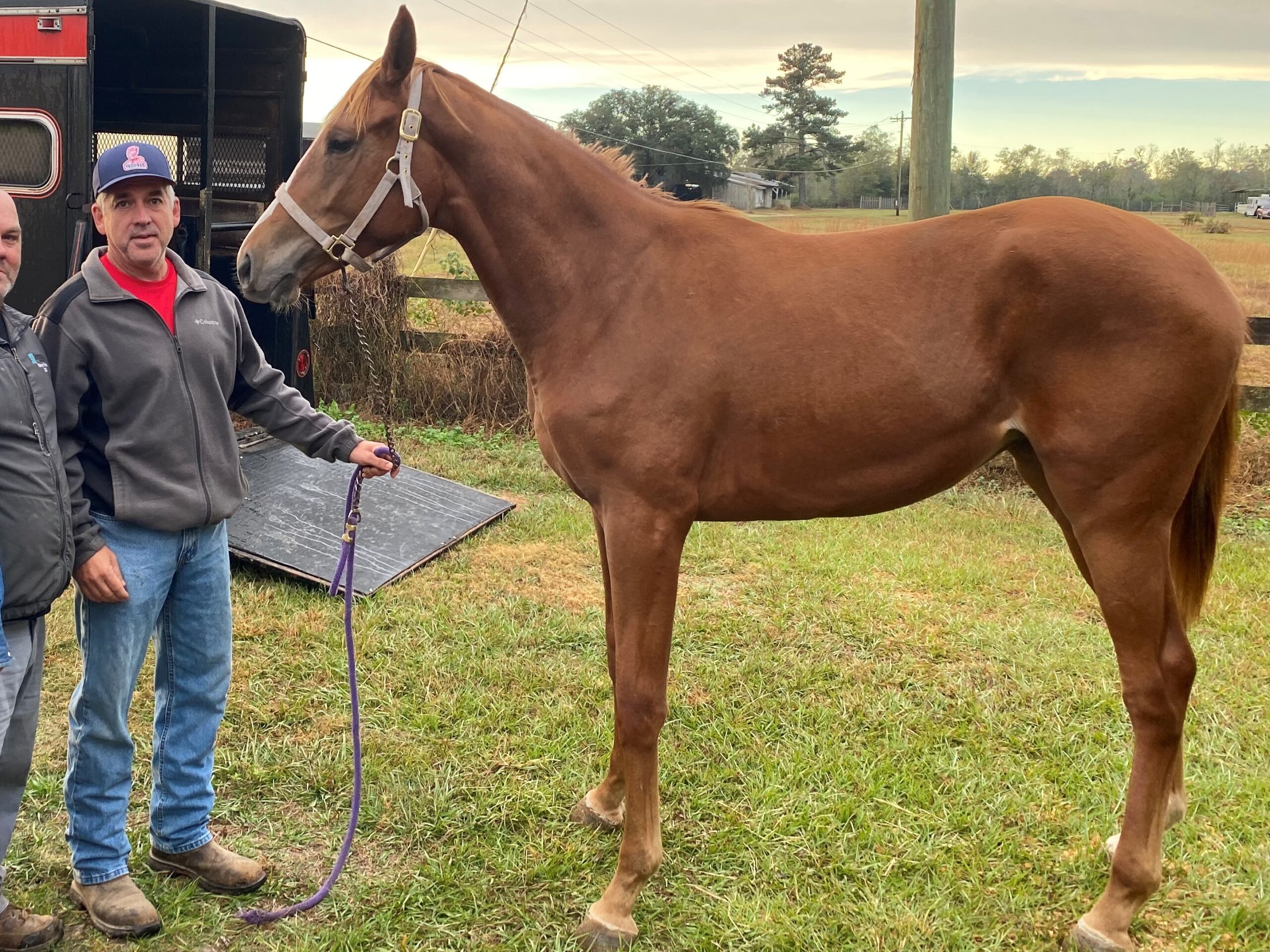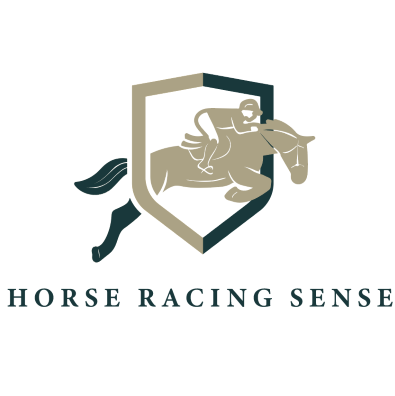Last updated: April 10, 2025
Racehorses wear blinkers to help them stay focused, avoid distractions, and perform their best on the track. If you’ve watched a horse race, you’ve likely noticed some runners wearing unusual headgear—small cups beside their eyes. These are blinkers (or blinders), and while they may seem simple, they can make a dramatic difference during a race.
As a long-time racehorse owner with seven Thoroughbreds in training, I’ve used blinkers on many horses over the years—each for a different reason. Two of my current runners wear them: one to stay focused and avoid drifting down the stretch, and the other to break more cleanly from the starting gate. Both have shown noticeable improvement.
In this guide, I’ll walk you through what blinkers are, how they work, the different types trainers use, and why they’ve become a standard tool in competitive racing. We’ll even look at how a change in blinkers helped elevate Secretariat to new levels of dominance.

What Are Blinkers?
Blinkers are specialized pieces of horse tack designed to restrict a horse’s peripheral vision. Usually made from leather or durable synthetic material, blinkers attach to the bridle and feature cups positioned beside the horse’s eyes. These cups prevent the horse from seeing distractions beside or behind them, encouraging a forward-focused mindset.
Explore more in our Complete Racehorse Equipment Guide.
Why Do Racehorses Wear Blinkers?
Trainers use blinkers for various reasons, depending on the horse’s behavior and needs. Here are the most common benefits they provide on the racetrack:
1. Improved Focus and Concentration
Horses naturally have a panoramic field of vision—up to 350 degrees—thanks to their wide-set eyes. While this is ideal for spotting predators in the wild, it can be problematic on a noisy racetrack. A horse might become distracted by other runners, the crowd, or the environment.
Blinkers limit this peripheral view, helping the horse concentrate on the track ahead and the jockey’s cues.
Learn more about equine vision in this guide from Iowa State University.
One of the colts I race tends to lose focus when another horse pulls alongside him in the stretch. He’ll start looking around or hesitate just enough to cost him momentum. After adding semi-cup blinkers, he began running straighter and keeping his head in the race—literally. It didn’t change his raw ability, but it helped him apply it more effectively when it mattered most.

2. Reduced Anxiety and Spooking
As prey animals, horses are hardwired to react quickly to perceived threats. This flight instinct, while useful in nature, can cause problems during a race. Blinkers help nervous horses by limiting overwhelming visual stimuli and reducing the chance they’ll spook or become unsettled.
If your horse struggles with performance anxiety or stress, understanding the underlying causes can make a huge difference.
Read our full article on Behavior and Stress in Racehorses.
3. Better Racing Performance
Some horses tend to drift, veer, or “lug” toward the rail or other horses mid-race. Blinkers promote a straighter, more consistent running line by removing side-view distractions. Horses who are reluctant to pass others or who lose interest mid-race often improve once they’re focused only on what’s ahead. Blinkers can also help horses break from the starting gates quicker.
One of my fillies, who consistently ducked in when another horse challenged her late in a race, began running straighter and more confidently once we added a semi-cup blinker. It didn’t change her natural ability—but it let her use it.
4. Enhanced Safety
Distractions on the racetrack don’t just affect performance—they can endanger the horse, jockey, and fellow competitors. Blinkers help prevent sudden movements or erratic behavior that could result in a collision or loss of control. Their use is governed by racing commissions under official equipment rules, ensuring their application aligns with safety standards.
Explore more in this NIH-backed study on racehorse welfare and performance.

Potential Downsides of Blinkers
While blinkers offer many benefits, they aren’t without risk:
- Overdependence – Some horses may become reliant on blinkers and perform poorly without them.
- Limited Vision – Excessive restriction might make it harder for a horse to react to another horse cutting in front.
- Discomfort or Stress – Poorly fitted blinkers can lead to physical irritation or psychological stress, especially in sensitive horses.
Types of Blinkers and Their Uses
Here’s a breakdown of the most common blinker types used in horse racing:
| Blinker Type | Description | Primary Purpose | Best For |
|---|---|---|---|
| Full-Cup Blinkers | Fully cover the side of each eye, blocking most peripheral vision. | Maximum focus and distraction elimination | Highly reactive or easily distracted horses |
| Half-Cup Blinkers | Cover part of the eye, allowing limited peripheral view. | Moderate focus with some environmental awareness | Horses needing redirection, not full cutoff |
| French Cups (Cheaters) | Small slit or hole cut into the cup; minimal restriction. | Light focus correction without full coverage | Experienced or calm horses with minor issues |
| Customized/One-Sided | Block vision on just one side (left or right). | Targeted correction (e.g., drifting or lugging) | Horses veering one direction consistently |
The right type of blinker depends on each horse’s individual temperament and behavior. I often adjust blinker types based on how the horse responds—starting with cheaters and moving to full cups if needed, or downgrading if the horse shows signs of stress.

The Trainer’s Role: Customizing for the Horse
Trainers play a vital role in determining whether a horse needs blinkers. They assess:
- Temperament – Is the horse naturally focused or reactive?
- Behavior During Races – Does the horse lose concentration, drift, or resist passing others?
- Training Trials – Blinkers are often tested in workouts to compare how the horse performs with and without them. Learn more about how trainers approach this in our article on racehorse training techniques.
Some horses also benefit from other performance gear like tongue ties, which help prevent displacement of the soft palate or improve breathing.
👉 Here’s why some racehorses race with their tongues tied.
Through observation and trial, trainers decide whether blinkers enhance a horse’s comfort, confidence, and speed.
Famous Example: Secretariat and His Blinkers
Even the greatest benefit from better focus.
On June 6, 1973, Secretariat wore blinkers for the first time to help keep his attention forward during a workout. The result? A strong half-mile in 47 3⁄5 seconds. Later that month, on June 24, he clocked the fastest 6-furlong workout of the day—1:12 4⁄5—on a sloppy track. Learn more in this Daily Racing Form article on how blinkers impact performance.
These performances helped cement the idea that blinkers, when used correctly, can enhance focus and fine-tune a horse’s natural ability—even for a legend.

Frequently Asked Questions (FAQ)
Here are answers to some of the most common questions horse owners and racing fans ask about blinkers.
Do all racehorses wear blinkers?
No. Blinkers are used based on individual needs. Many horses run well without them, while others benefit from the added focus and calm.
Can blinkers negatively affect a horse’s performance?
Yes. If a horse feels restricted or stressed by blinkers, they may run poorly. That’s why trainers often test them in workouts first.
What does “blinkers on” or “blinkers off” mean in a race program?
These terms indicate a change in equipment. “Blinkers on” means the horse is wearing them for the first time or returning to them. “Blinkers off” signals they’ve been removed.
Are blinkers legal in all races?
Yes, in most jurisdictions. Their use must be declared, and they must conform to the equipment rules of the racing commission.
Can blinkers help horses at the gate?
Yes. Some horses struggle to focus when loading or breaking from the gate. One of my horses wears blinkers specifically to improve his break—and it’s made a big difference in his early speed.

Conclusion
Blinkers are more than just an accessory—they’re a strategic tool that can help racehorses stay focused, perform better, and remain safe in high-speed environments. But they’re not a one-size-fits-all solution. Using blinkers requires careful observation, a deep understanding of the horse’s temperament, and thoughtful evaluation by experienced trainers.
Want to learn about the other types of headgear you’ll see on racehorses—like fly masks, shadow rolls, and visors?
👉 Read why horses wear masks and what each one does.
Have you used blinkers with your horses? Have you noticed changes in their behavior or performance? Share your stories and insights in the comments—we’d love to hear how this simple piece of gear made a difference in your racing journey.
Want to see blinkers in action and learn how they affect racehorse behavior? Check out this quick video demonstration:

About the Author: Miles Henry
Lifelong Horseman | Racehorse Owner | Published Author
Miles Henry brings over 25 years of hands-on experience training and owning Thoroughbred racehorses. Raised with Quarter Horses and Appaloosas, he’s spent a lifetime learning from horses—on the track, in the barn, and in the field. Today, he runs a small but successful racing stable in Louisiana and shares real-world insights on HorseRacingSense.com, helping horse owners, fans, and bettors navigate the sport with confidence.
📚 Books: View Miles’s books on Amazon »
🎧 Podcast Guest: Animal Tales Ep. 32 |
YouTube Interview
📩 Newsletter: Sign up for racing tips and horse care advice »
🔗 Follow Miles:
Twitter |
Facebook |
YouTube


